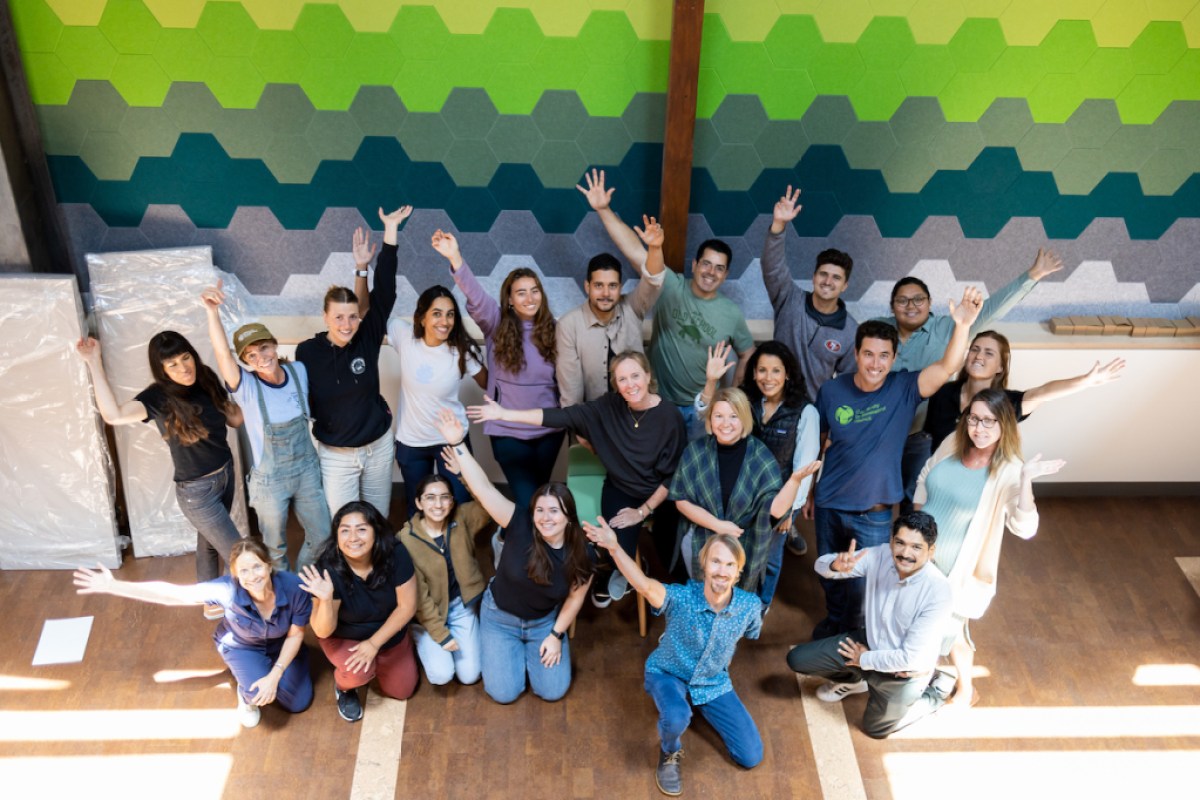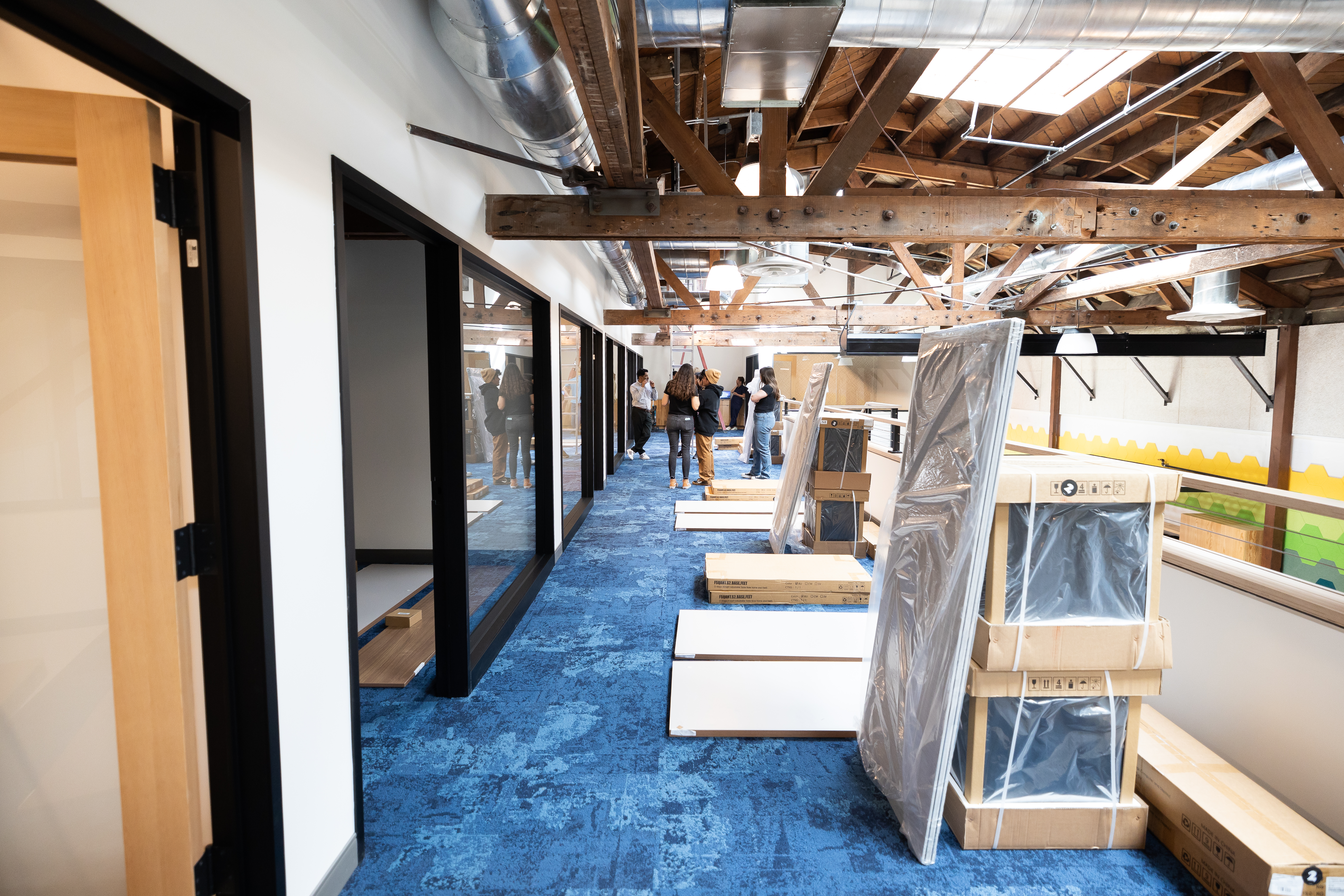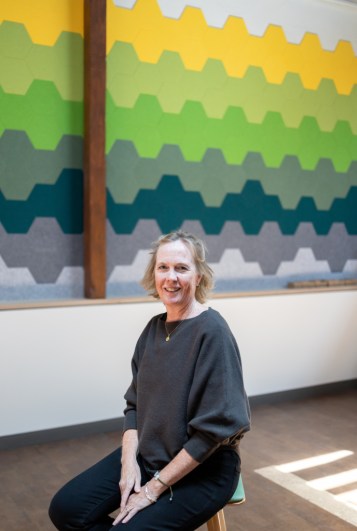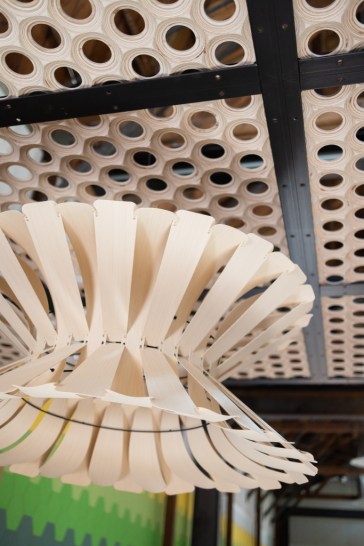CEC’s New Environmental Hub Sprouts in the Heart of Downtown Santa Barbara
A Focal Point and Incubator
for Climate Activism and Awareness
By Callie Fausey | Photos by Ingrid Bostrom
July 6, 2023

A tree blooms through the floorboards of a State Street construction site. Its roots reach down into the Earth’s soil, its branches extend upward, and its green leaves shine under a speckled constellation of light.
The juvenile ficus is a sprouting metaphor for the space that houses it: the Community Environmental Council’s (CEC) new “Environmental Hub.” Amid the din of electric tools, the tree thrives in its bright indoor environment, symbolizing the growth and potential of the Central Coast nonprofit and its new home.
This space aims to foster creativity and collaboration to address environmental issues, paralleling how the soil and light nurture the tree. Never mind that it’s maintained by “Steve Jobs’s arborist” Dave Muffly, who was Apple’s tree guy and happens to live locally.
“He’s telling me it’s fine because we’re seeing new leaves,” says Sigrid Wright, the nonprofit’s Chief Executive Officer. She gives one branch a gentle shake, and a little plume of dust disperses into the air. “Even though that makes me nervous,” she chuckles, “but it should get really big, all the way up to the ceiling.”
Time for Change
The 10,000-square-foot Environmental Hub has lofty goals beyond tree growth: It intends to serve as a focal point for activism, education, entrepreneurship, media, and art — the first hub of its kind in Central California.

“We believe very strongly that while this is being experienced globally, solutions come at the regional, local, and even neighborhood level,” Wright says. “It will be people working together, and we are here as a resource and a space for that work to happen.”
Following the loss of their former office (it sold to Westmont Downtown at the end of 2020), the CEC embraced this change of space alongside their adoption of an accelerated strategic plan — to double down and do twice as much twice as fast on climate change.
The old building was owned by the Hutton Parker Foundation, which supports nonprofits with affordable office spaces, and its founder, Tom Parker, helped Wright locate a suitable building and contributed significantly to the development of the Hub.
Initially, when shown the space at 1219 State Street — which previously housed the State Theater, Unity Shoppe, and Youth Interactive — Wright thought it was much larger than what the CEC needed, even though they were growing.
But she always held this idea of being on State Street, increasing CEC’s visibility and community engagement. “The type of work that we’re doing requires a lot of people. We also need to have space for whatever wants to emerge, whatever people bring in.”
Wright described the unfolding chain of events as “once-in-a-lifetime.” Converging milestones, including finalizing their strategic plan, moving to the new building, envisioning the hub, and launching a successful fundraising campaign, created a serendipitous opportunity. Their Protect Our Climate Campaign raised a significant portion of the $3.5 million needed to bring their vision to life.
“It felt very, for lack of a better word, cosmic,” Wright says.
A Tour of the Hub
Nestled in the heart of Santa Barbara’s Arts District, the Environmental Hub is a beacon for environmental synergy right across the street from The Granada Theatre, with flexible spaces to accommodate both in-person and remote collaboration.
Upon entering the Hub through its front doors off State Street, visitors encounter glass-cased offices and conference rooms that will be leased to other nonprofits and grassroots activists as affordable co-working spaces.
To the right of the entrance, a reception desk crafted by local artisan Guner Tautrim of Seaborn Designs welcomes guests. But it’s not just any desk; the unique piece is made from salvaged urban timber, including wood from trees damaged in the 2008 Montecito Tea Fire.
The reclaimed-wood reception area introduces visitors to the Hub’s myriad of recycled and biodegradable building materials, right down to the cork flooring and up to the wood-fiber ceiling panels. Designed by Joe Andrulaitis of Andrulaitis + Mixon Architects, the all-electric building will also boast a high-efficiency electric heating and cooling system, natural lighting, and a planned 16kw solar system.

Other key design partners — including Natalie Greenside and Melissa Mohr Brown of MN Studio, Specialty Construction, and Terra Basche of Lush Elements — contributed their expertise to enhance air quality, natural light, and acoustics, and create an inviting, earthy style that permeates the entire space.
Beyond the tenant offices, the lower level houses the Patricia & Paul Bragg Foundation Atrium, featuring the flourishing ficus tree with a bench encircling its base, and the building opens up into a spacious two-story layout.
“We want the entire space to have a natural feel,” Wright says.

During the design process, skylights were installed, revealing original 1930s Douglas-fir hardwood rafters, which were left exposed. This vintage element adds a touch of charm to the atrium, complemented by the streaming golden sunlight that highlights the tree-hugger’s haven below.
Adjacent to the tree, funky metal bike racks in a vibrant marigold color are attached to the wall. “They’re my favorite color,” Wright says, admiring the half-installed racks. To the left of the tree, private cubicles, known as “Zoom booths,” provide space for remote calls and meetings.
At the center is the Hal Conklin Community Room, named in honor of one of CEC’s founders, with 750 square feet of meeting space, which can be divided into three separate rooms.
Throughout the atrium, desks and other seating arrangements will encourage brainstorming sessions. Toward the back, situated against a vibrant wall adorned with colorful, hex-shaped wool-felt panels, a break area will offer coffee and snacks.
Those panels will feature storyboards illustrating the organization’s history. Along with other building materials, they are designed to soften the sound of overlapping conversations and were sustainably crafted. Each tile contains the equivalent of four recycled water bottles.
Ascending the wooden stairs (also recycled) alongside the glass community room reveals CEC staff offices lining the second-floor balcony. The sea of carpeting underfoot features a deep-blue hue and is made from repurposed discarded fishing nets. Peer over the floor’s railing, and the entire atrium comes into view.
As Wright gazes over the balcony, she envisions a vibrant gathering of forward-thinking grassroots activists within the space. “My people, my people,” she says with a playful tone and sweeping gesture. A good space, she adds, lends itself to creative and imaginative thinking.

Thursday, July 6, from 5-8 p.m. | Credit: Ingrid Bostrom
The Hub will host community art installations, movie screenings, exhibitions, educational events, and other engaging activities aimed at informing and involving the public. The inaugural program coincides with the opening, featuring an installation by environmental artist Elizabeth Weber. Her pieces focus on the western monarch butterflies that once overwintered in California by the millions, and whose population has reduced by 90 percent from the 1980s due to climate change, loss of habitat, and pesticide use.
Construction on the hub began on Labor Day last year. The organization’s vision was to design a space that harnesses the ultimate renewable resource — human ingenuity and creativity.
Height of Wright’s Career
Amid rising global temperatures and the increasingly tangible impacts of climate change, climate anxiety has reached new heights. Wright, sitting in the back of the Hub on an old office chair, acknowledged that she is in a unique position in that context.

“I absolutely have that level of anxiety,” Wright explains, occasionally cut off by the whir of an electric saw. “But I also have a 30-year career of seeing how progress can be made.”
Despite progress often feeling slow and incremental, Wright’s experience has shown her that change can happen. She believes in humanity’s ability to “pull it together at the last minute,” drawing confidence from her 25 years with CEC. She became CEO in 2015 and was at the helm for the organization’s recognition as California Nonprofit of the Year in 2020, as well as her own honor as Congressional Woman of the Year in 2022.
For Wright, the creation of the Environmental Hub represents a pinnacle in her career, after years of incremental and sudden progress. She sees it as a remarkable moment in time, feeling that the strengths and gifts of the organization are being recognized by the community.
Following the 2018 Thomas Fire and debris flow, Wright noticed a shift in the Santa Barbara community’s awareness as they began connecting the dots between climate change and extreme weather events. A light bulb went off, she says, prompting a sense of urgency that climate change is not a distant future concern but a current reality.
“I have said time and time again that as long as there’s breath in my body, I am going to be working on this [climate change]. And if I wasn’t, I’d have to be medicated.”
50 Years Later
The Environmental Hub was the cornerstone of CEC’s 50th anniversary campaign, which launched in 2021 and raised more than $16.97 million to support regional climate solutions. Around $10 million was allocated for the Hub’s creation and ongoing initiatives, fueling the organization’s accelerated strategic plan to expand their climate goals and reach, while doubling their programming and their staff.
While the cost of the Hub ($3.5 million) has drawn reactions along the lines of, “Oh my God, that’s a lot of money,” Wright emphasizes that it is a relatively small expense compared to the magnitude of climate change.
“It is a lot of money,” she says, but without dampening the gratitude CEC has for their donors, “It’s just the beginning of what is really needed, in terms of investment for solutions to the most pressing issue on the fate of humanity and the well-being of our region.”
CEC has a rich history spanning more than 50 years, starting with their founding in 1970, born out of the 1969 Santa Barbara oil spill (the country’s largest at the time, ranking third now). They have championed Central Coast recycling efforts, renewable energy systems, climate justice and resilience, food recovery, and waste reduction.
Recent successes include increasing access to electric vehicles for disadvantaged communities, advocating for plastic reduction laws in Goleta, and supporting statewide packaging and recycling regulations.
The organization has also launched their Climate Stewards certification program, educating more than 100 individuals to date, and giving them the tools and guidance to implement climate projects in their communities. The Hub will be a place for climate stewards to train, connect, and “create the juice to do what is needed in their own neighborhoods,” says Wright.
Patagonia-Wearing White Environmentalists
CEC’s growth since 2021 has been strategic and intentional, focusing on expanding its reach and shifting its attention to low- and moderate-income communities and Spanish speakers.
Wright emphasizes that she and her fellow “Patagonia-wearing white environmentalists” don’t have all the answers. “This community doesn’t really need us to tell them how to get a Tesla, or help the über-rich install solar on their homes.”
She acknowledges that real solutions call for systemic change, including addressing racial inequities and social injustices that contribute to climate change. “There isn’t going to be an end-of-pipe fix to all this; it isn’t going to be all those technological solutions and solar homes and electric vehicles,” she says. “Baked into our approach is really looking at addressing and solving for the conditions that led to climate change.”
She believes that the problem requires a multigenerational effort, involving all socioeconomic, racial, and age groups. “I hear someone in my circle say, ‘We have to engage the youth because it’s their problem to solve,’ ” she says. “That just really rubs me the wrong way. What a shitty thing to do to the next generation.”

She continues, “Absolutely, we have to engage the youth, but we also have to engage elders because they have the wisdom and oftentimes the experience to inspire solutions.”
As CEC has branched into North County areas like Santa Maria, and further south to Ventura, they have recruited more staff and have also invested more resources in communities most vulnerable to climate change through environmental justice initiatives, including the Central Coast Climate Justice Network.
To build Spanish language capacity, CEC has expanded on translation, interpretation, and consultation services through a partnership with Rooted Language Justice. Bilingual materials, including the paneled storyboard in the Hub, are meant to ensure broader community access.
But the starting line was interpreting CEC’s name to convey who they are, which can’t be done through Google Translate. In Spanish, the CEC is El Consejo Comunitario del Medioambiente and the Environmental Hub is El Centro Ambiental.
“We have a lot more work to do in that area,” Wright says. “But I feel really proud of how far this team has come in the last two years in terms of accessibility and engagement with multilingual community members.”
In 2022, the nonprofit began offering spaces like “Nuestro Tiempo” for Spanish-speaking individuals to learn about climate change, share ideas and concerns, and take action. It’s meant to empower participants to be in community, ask questions, seek information, and build confidence to speak up and engage in local politics.
Wright says CEC aims to listen to individuals who may not identify as the typical environmentalist, but who have important ideas that are sometimes lost in the mix of the loudest, Patagonia-wearing voices.
“Again, that gets back to space,” she says. “I’m not here to tell you how it’s all going to go down. I’m here to provide a space so you can develop your own solutions and contribute to this work in your own way.”
Starting on State Street
This milestone for Santa Barbara’s climate-resilient future is set along the city’s pulse, which itself has not seemed so resilient in recent years. CEC sat down with city councilmembers and other community leaders to ask what State Street needs and what they could offer, and the idea for the Hub emerged.
“I think we’re at that pivotal moment, in terms of what the vision is for State Street. My vision for State Street, though, is that it stays closed,” Wright says. “Then it’s a vibrant center for retail, arts, and entertainment, but also just for the community to come and be without having to spend money.”
Wright says they are hoping to anchor their section of State, and create a welcoming space where people can put their time and energy into strengthening the community. “Go out to eat, go shopping, and get your ticket to the Granada, but this is a place where you can come to be inspired and design solutions to environmental and social problems.”
Assemblymember Gregg Hart is a “big fan” of the organization, saying he’s always thought of them as forward thinkers who have had a calculable impact on the region. “I’m particularly excited to have the Hub on State Street, so people visiting Santa Barbara can connect with the amazing things this community is doing.”

Community residents, organizations, and leaders are invited to see the Hub for themselves and imagine the solutions that may sprout within its walls, just like the ficus.
“It’s smart to rejuvenate existing spaces to meet the current needs of our community,” shares Supervisor Laura Capps. “I commend the Community Environmental Council on reimagining their new State Street location to bring life to a once-empty building and developing a space to be collaborative and innovative in healing our climate.”
“A physical space can have as much importance as the people who are doing the work,” Wright says. “For us, this will be the space in which we deepen our work. But more importantly, it will be an inviting space where other organizations can affordably meet and convene.”
With that in mind, spaces are available to the public to rent for meetings and events starting in July, and hot desks will also be available to book in the coming months. In addition, CEC is inviting local nonprofits to “test drive” the space, free of charge, later this summer.
Email environmentalhub@cecmail.org to learn more.





You must be logged in to post a comment.